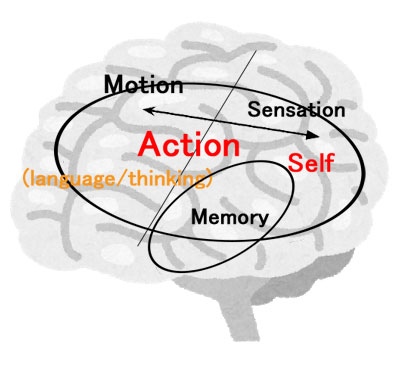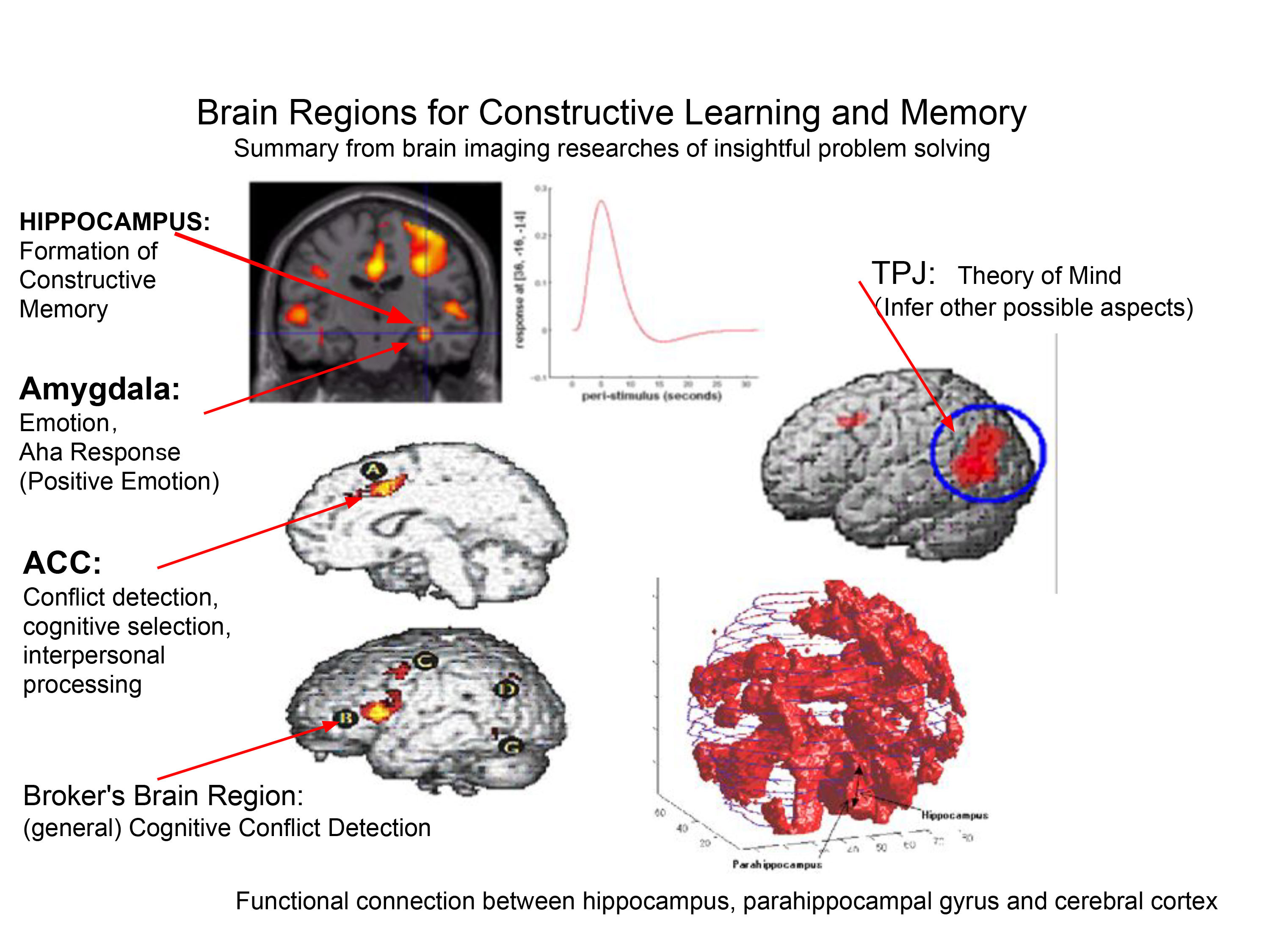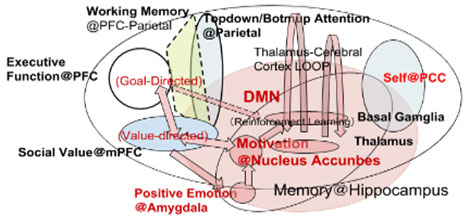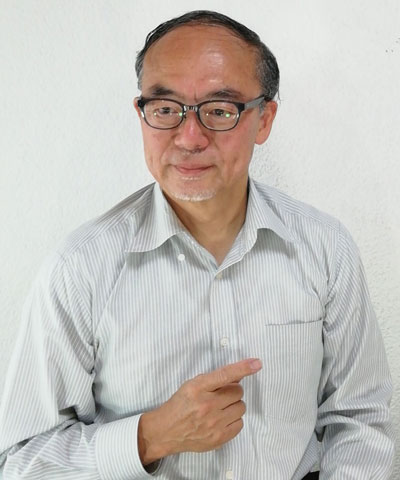Active learning is expected to play an essential role in the recent educational reforms initiated by the Japanese government. To appropriately disseminate active learning pedagogies, we launched a research project to establish a theory of learning that can comprehensively explain the characteristics and phenomena of active learning from the perspective of cognitive brain science (under the Grant-in-Aid for Challenging Research (Pioneering) Program). We aim to promote active learning - the human innate ability to learn - in educational settings. To achieve this mission, we are working to clarify the mechanism of the "enactive brain" that supports the independent and active learning and development of human beings for their entire life from the perspective of cognitive brain science. Ultimately, we propose to accurately understand, positively promote, and utilize the features of the enactive brain, which have tended to become suppressed in the conventional education system.
Education is defined as activities in the "place of learning," which help children enjoy learning vividly with excitement and enthusiasm and grow as an active learner. The enactive brain also closely relates to positive psychology. Active learners can fully enjoy their daily/social life and enhance the quality of life even when they get older. This lifelong learning is one of the underlying goals of this project.
As discussed above, this project aims to utilize and promote the human innate ability to learn with a research study on the "relationship between brain science and education," offering results that enable human learning and growth, which is a bit different from conventional learning and educational studies. We have been studying what happens in the brain when active learning occurs, using brain imaging technologies.
Humans learn from actions with motivation and intention
To clarify the mechanism of "independent/proactive learning," we focus on actions with motivation and intention, the human inherent ability. When humans achieve an intended goal due to their action, episodic memory is formed, which is specific to humans (we name it "Learning and Memory in Action"). This is also known as "Constructive Learning." Constructive learning occurs when we have successfully realized, understood, or achieved something that we have hitherto been unable to realize, understand, or achieve. Constructive learning has all the features of learning and memory (robustness, flexibility, adaptability, etc.) that are a focus of active learning.
In fact, actions are the key to understanding the human innate ability to learn!
By focusing on actions, we can discuss education as collaborative work between an "actor of learning" and an "actor of teaching." In this collaborative work, the teacher and the learner influence their actions with each other through "intended communications." The learner will learn through the "actions of learning."
Since John Dewey's time (Note 1), "episodic memory" has been a focus of educational reforms. By positioning "episodic memory" as the "memory of episodes acquired by the learners through their action of learning," we can clearly understand the importance of teachers' roles and the stance of education. This leads to clear rationality that each learner with different personalities and characteristics should voluntarily learn because "action"is the voluntary act of the learner. In addition, episodic memory acquired through personally experienced actions will help the learner grow further, by changing the quality and content of future learning (i.e. constructive learning). The ideal concept and goal of active learning are to nurture the learner to become an active learner who can systematically and constructively develop his/her abilities, and ultimately, to become a transformer who can independently and voluntarily transform such abilities.
Brain science of active learning
Actions require not only cognitive functions such as thinking, but also non-cognitive functions and socio-emotional skills such as memory, motivation, emotion, motion, somatic sensation, and sensibility. Conventional education and learning pedagogies tend to focus solely on the functions of the lateral prefrontal cortex (LPFC) that is responsible for logical thinking. In contrast, active learning occurs using the whole brain, as shown in Figure 1. Actions take place by fully utilizing the function of the front portion of the brain (handling external submissions such as motion and thinking), that of the back portion of the brain (receiving external sensations and impressions), and that of the middle and deeper parts of the brain (handling memory, motivation, emotion, self-formation skills, and socio-emotional skills). As a result, robust memory can be obtained through the active learning process.
 Figure 1: Actions and active learning occur using the whole brain
Figure 1: Actions and active learning occur using the whole brainAha!-Moments: Constructive learning associated with a feeling of elation
The theory of constructive learning has not yet been established in the fields of conventional psychology and educational psychology. Here, I will introduce our neuroscience study on constructive learning that is a focus of active learning.
When we find an answer to a question we are eager to solve, we think, "Aha! I see now!" with a feeling of excitement or elation, and at the same time, memorize the solution process and the answer. This is accompanied by many pieces of memory data, such as when, how, and in what situation the aha!-moment occurs.
To clarify such phenomena of learning and memory, we conducted a brain-imaging research study on "Insightful Problem-Solving" (Note 2) using riddle tasks. Figure 2 summarizes the activities that occurred in the brain region when the research participants found an answer to the riddle and experienced the aha!-moment with a feeling of elation.
 Figure 2: Significant activities in the brain regions when constructive learning occurs with the Aha!-Reaction
Figure 2: Significant activities in the brain regions when constructive learning occurs with the Aha!-ReactionAccording to a study using rats, when memory formation occurs, a considerable spine synapse (Note 3) is generated in the hippocampus and retained for several months. In the case of humans, it is said that the memory will be retained for the entire life span. We consider that this considerable spine synapse generates the binding memory (Note 4) of information regarding the functional connection with the brain cortex that contributed to successful actions. When we recall such memory, it is possible to vividly recall the experienced event by reproducing almost the same activities in the brain cortex.
"Enactive Brain" responsible for active learning
Figure 3 shows the structure and functions of the "Enactive Brain" that are responsible for active learning. The AL-Core Network (see Figure 2) responsible for constructive learning belongs to the Default Mode Network (DMN) (Note 5). The AL-Core Network comprises mainly of the hippocampus (serving as the memory center), the amygdala (serving as the emotional center), the anterior cingulate cortex (ACC) (responsible for the functions of cognitive switching and interpersonal cognition), and the temporo-parietal junction (TPJ) (responsible for the theory of mind). This network generates "memory," "playful/positive emotion," "motivation" and "self-formation," which are critical for active learning.
In addition, the AL-Core Network works in conjunction with the PFC-Parietal Network (Note 6), the Attention Network (Note 7), and the Salient Network, and all of which are located adjacent to the AL-Core Network. The co-operation between AL-core Network and PFC-Parietal Network generates "goal-oriented motivation" and "self-regulated learning" that are also critical for active learning.
Meanwhile, the LPFC (which handles logical thinking and intuitive/heuristic judgments) may, when sufficient information necessary for problem-solving is lacking, have access to long-term memory through the parietal lobe (which belongs to both AL-Core Network and PFC-parietal Network) which handles working memory and trigger more profound learning.
 Figure 3: Structure of the "Enactive Brain"
Figure 3: Structure of the "Enactive Brain"Implications for active learning from the perspective of cognitive brain science
When we look into the functions of the "enactive brain" that support active learning from the perspective of cognitive brain science, we can recognize some problems in conventional teacher-initiated teaching as well as necessary conditions to promote active learning. I will explain some relevant factors as follows:
- Positive emotions can activate the constructive learning.
- The medial prefrontal cortex (mPFC) is involved in positive emotions, socio-emotional skills and assessments. The outcome will be received by the amygdala, and then expressed as emotions.
- Strong negative emotions may hinder constructive learning.
- Motivation is a driving force of active learning, which could be transformed and advanced to value-oriented motivation or achievement-oriented motivation through learning. This should be one of the goals of active learning.
- Surface learning is a passive reception/processing of information received from external sources. In surface learning, the PFC-Parietal Network restricts the Default Mode Network (DMN); therefore, constructive learning will not occur.
- The brain coordinates information processing to achieve the intended purpose. Therefore, it is necessary to ensure that learners have a clear "intention of learning."
Learners have the natural/instinsic ability to carry out the "act of learning" with motivation and intention. However, the conventional education system seems to underestimate the importance of emotions, motivation, and socio-emotional skills revealed by the brain science of the enactive brain. The active learning education must properly develop these elements and enhances gradually socio-emotional skills such as "learning motivation," "learning intention," growth mindset, passion, and grit during the compulsory education period.
To ensure that everyone receives benefits from education and utilizes the innate human ability to learn, it is necessary to re-design a comprehensive education system for learning and teaching. More specifically, it is necessary to reconstruct the system of learning and teaching to come up with one that can encourage learners to appropriately learn and develop the innate human ability of "action" based on evidence acquired from brain science relating to active learning. I wrote this article with the hope of sharing such information with our readers.
* This research study has been conducted under the Grant-in-Aid for Challenging Research (Pioneering) Program (18H05318). This article was prepared based on the articles for the Poster Presentation at the Japanese Society of Child Science Conference (Kazuhisa Niki, Makoto Yururi, Shoka Utsumi, Takayuki Iwano, Kie Fujiwara, and Yoichi Sakakihara; 2018) and for the Symposium of the Japanese Association of Educational Psychology (Kazuhisa Niki, Makoto Yururi, Shoka Utsumi, and Kie Fujiwara; 2019).
- Note 1: John Dewey was a pragmatist philosopher, functionalist psychologist, and practitioner of empirical education reforms. He demonstrated his educational theory that was to research students' voluntary development and social/life tasks in the "experiential classroom," which significantly affected the education world at that time. Theoretically, his concept was remarkable; however, his efforts brought only limited success and many failures in experiential learning that requires learners to "crawl around" from one site to another. I would like to point out one issue that his theory did not properly focus on the learning and development of students. If Dewey had been aware of the "enactive Brain" discussed in this article, he would have focused on students' motivation, intention and goal of learning. He would also have found the "zone of learning" like Zone of Proximal Develop and students' "learning and development" through the collaborative work between learning and teaching, instead of focusing on only experiences.
- Note 2: Jing Luo and (CA) Kazuhisa Niki: Function of Hippocampus in "Insight" of Problem Solving, Hippocampus 13:3, pp.274-281 (2003), Luo Jing, (CA) Kazuhisa Niki, Steven Phillips, Neural correlates of the "Aha! Reaction", Neuro Report Vol.15, No.13, pp.2013-2017(2004)
- Note 3: Signals are transmitted from the nerve axon to dendritic spines via synapses. Recently, it becomes possible to observe the development or disappearance of a connection between dendritic spines and synapses. With a two-photon microscope, in particular, it is now possible to observe that a considerable "group of spine synapses" is generated and retained for more than one month along with the formation of memory in the hippocampus. As a result, it is confirmed that the memory formed in the hippocampus is long-term memory.
- Note 4: The formation of spinesynapses explains that the experience of a specific event generates robust episodic memory, and at the same time, triggers a state of binding memory based on the status of brain activities at the time of such experience as the input source of synapses. Due to this memory mechanism, it is possible to re-experience the event by recollection.
- Note 5: The Default Mode Network (DMN) is active all the time even during sleep or rest, and consumes 70% or more of the metabolic energy of the brain. When an easy cognitive task is given, for example, the visual cortex and the frontal lobe become active to process the task, and at the same time, the activity of the DMN is restricted. For this reason, the DMN was considered as a useless brain area for a long time. However, as our study shows, the DMN is a vital area that recalls, forms, and reconstructs memory when challenging a problem with no clear solution or raising a problem. The DMN also performs orientation functions such as when and where memory is generated. Furthermore, memory and schemas about the self are formed in the DMN. In this way, the DMN generates episodic memory through actions, and forms memory and schemas about the self, based on the aggregated memories. Therefore, the DMN plays a vital role in supporting the learner in voluntary learning and development.
- Note 6: The PFC-Parietal Network is a brain network connecting the LPFC and the parietal lobe, which is responsible for the functions of working memory. More precisely, the LPFC is responsible for the executive functions of heuristic and logical thinking, while the parietal lobe is responsible for the blackboard function of working memory. The blackboard function handled by the parietal lobe is very active, including the functions of top-down attention and bottom-up attention. This blackboard function can expand insufficient information by accessing long-term memories such as those in the DMN. As a result, this can trigger active learning that generates new memory. However, the relationship between this network and the DMN is generally restrained. In particular, in a traditional adult-oriented classroom that compels students to learn, active learning does not occur easily. In order to make active learning work successfully, it is important to provide a place of learning that is full of positive emotions, and encourage students to have motivation and intention to learn and voluntarily perform the "act of learning."
- Note 7: The Attention Network is a brain network that controls the function of top-down attention. This network coordinates with the frontal lobe and controls the functions of working memory handled by the LPFC and the parietal lobe.



 Dr. Kazuhisa Niki graduated from the University of Tokyo Faculty of Engineering in 1974, and was awarded a Ph.D. in Engineering from the University of Tokyo in 2010. He joined the Electrotechnical Laboratory (the current National Institute of Advanced Industrial Science and Technology (AIST)) in 1974 and engaged in research studies on bionics, artificial neural network models, and cognitive science. After working as a visiting researcher at Carnegie Mellon University in the US and the director of the Cognitive Science Laboratory, he currently serves as a visiting researcher at AIST’s Human Informatics Research Institute and the Ochanomizu University’s Institute for Education and Human Development. Since 2000, he has been working on brain imaging studies focusing on cognitive brain science to clarify the innate human ability to learn and memorize. He is also involved in the Strategic Basic Research Programs “Brain Science and Education” carried out by the Japan Science and Technology Agency. He is currently working on the “Understanding of Active Learning from the Perspective of Cognitive Brain Science” project under the Grant-in-Aid for Challenging Research (Pioneering) Program, aiming to establish useful guidelines for schools based on the theory of active learning.
Dr. Kazuhisa Niki graduated from the University of Tokyo Faculty of Engineering in 1974, and was awarded a Ph.D. in Engineering from the University of Tokyo in 2010. He joined the Electrotechnical Laboratory (the current National Institute of Advanced Industrial Science and Technology (AIST)) in 1974 and engaged in research studies on bionics, artificial neural network models, and cognitive science. After working as a visiting researcher at Carnegie Mellon University in the US and the director of the Cognitive Science Laboratory, he currently serves as a visiting researcher at AIST’s Human Informatics Research Institute and the Ochanomizu University’s Institute for Education and Human Development. Since 2000, he has been working on brain imaging studies focusing on cognitive brain science to clarify the innate human ability to learn and memorize. He is also involved in the Strategic Basic Research Programs “Brain Science and Education” carried out by the Japan Science and Technology Agency. He is currently working on the “Understanding of Active Learning from the Perspective of Cognitive Brain Science” project under the Grant-in-Aid for Challenging Research (Pioneering) Program, aiming to establish useful guidelines for schools based on the theory of active learning. 










